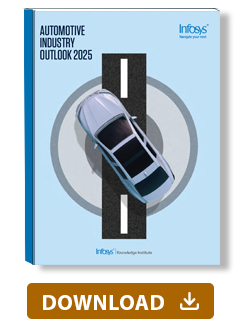Insights
- The automotive industry faces two primary imperatives: electrification of mobility, and emergence of software-defined vehicles (SDVs), progressing to a broader software-defined industry.
- Vehicle makers should balance their focus on revenue and profit margins — differentiate their products with new models and features, diversify their portfolio beyond electric vehicles (EVs), and focus on cost control.
- Carmakers should mitigate the risk of a slowdown in EV sales by diversifying their portfolio of vehicles, including hybrid and hydrogen fuel cell vehicles.
- Software is becoming a central component of modern vehicles. SDVs could account for 90% of vehicle production by 2029, up from only 3.4% in 2021.
- Carmakers should develop a comprehensive SDx architecture that integrates multiple interoperable SDx elements, while being flexible enough to accommodate legacy systems.
- OEMs should evaluate the formation of new semiconductor chip consortiums or enroll as member organizations in existing consortiums to mitigate the risk of supply disruptions.

Data as an Asset: The Friedkin Group’s Road to AI Readiness
Chad Watt speaks with Ken Elliott, Chief Data and Analytics Officer at The Friedkin Group, a diversified enterprise spanning automotive, entertainment, and hospitality.
Executive summary
The automotive industry faces two primary imperatives in 2025: Electrification of mobility, and emergence of software-defined vehicles (SDVs) progressing to broader software-defined industry. These trends are experiencing a push for faster and wider adoption but also face significant challenges.
A visible recent commitment to electric vehicles (EVs) occurred at the COP26 conference, and the shift to EVs is a key plank to achieve net zero. However, although sales of EVs reached 20% of 2024, US new vehicles sales, this pace was slower than expected. Global investments in EVs by vehicle makers — such as new EV factories, battery materials development, and new technologies — slowed due to falling demand.
Another significant industry transformation: Software is becoming a central component of modern vehicles. SDVs could account for 90% of vehicle production by 2029, up from only 3.4% in 2021. The market size for automotive software and electronics is forecast to reach $462 billion by 2030, growing at a compound annual growth rate (CAGR) of 5.5% from 2019. This shift requires shorter innovation cycles, continuous software updates, and transition from hardware-first to software-centric organizations.
In this report, we explore the broad contours of mobility electrification, software-defined automobiles, challenges, trends, the role of digital technologies, and provide recommendations to take action.
Financial insights
The global automotive industry is experiencing mixed financial performance in 2025, with moderate revenue increase coupled with margin pressure.
The average new car price in the US has hovered near record levels of $48,000, with 1.7% year-over-year volume growth projected for 2025. However, growth in global automobile sales volume has fluctuated the past few years, with a sharp decline during the pandemic in 2020, a recovery with an upward trend in the next few years, and 2.5% growth in 2024.
The pressure on profit margins is driven by tariffs, investments in new technologies (like EVs), raw material cost inflation, intense competition, and supply chain disruptions.
Figure 1 is a plot of 2024-25 revenue and profit margins or earnings before interest, tax, depreciation, and amortization (EBITDA) for the largest automotive companies. Interestingly, Porsche and Mercedes-Benz rolled back their decision to stop investments in new internal combustion engines (ICEs), which generate better margins. EVs tend to have lower and falling margins due to competition, commoditization, lack of differentiation, and high-cost batteries.
The automotive industry should balance its focus on revenue and profit margins. Carmakers should differentiate their products with new, higher-performing models and features; diversify their portfolios beyond EVs for revenue growth; and focus on the cost control initiatives explained in the following sections to maintain their healthy profit margins.
Figure 1. Annual revenue 2024-25 and net profit margin for carmakers
Industry dynamics
The automotive industry is challenged by geopolitical uncertainty in tariffs, regulatory pressure to achieve emission goals, supply chain resilience, and evolving technology landscape. A Future of Jobs 2025 study identified geopolitical tensions and trade restrictions as key drivers of change for the automotive industry — ranking much higher than other industries.
EV sales continued to be challenged by high upfront costs for vehicle procurement, insufficient charging infrastructure, limited driving range, and high battery costs, although the latter is on a downward trend due to falling battery metal prices. Steps are being taken to address these issues with networks of charging stations and inexpensive, higher-quality battery materials for faster charging and longer driving range. For the scope of this report, the three biggest challenges are the shortages of semiconductors, critical materials, and human talent.
The race for semiconductors
The automotive semiconductor market is forecast to reach $155 billion in 2032, up sharply from $68 billion in 2022. The popular electric/electronic or E/E architecture for SDVs will require two types of semiconductor chips: Mature chips with proven performance, reliable and cost effective; and advanced chips that are five nanometers or less with faster processing and advanced features. Mature chips are required for proven, basic functionalities, while advanced chips are needed for emerging trends such as SDVs.
Warnings abound of an impending shortage of mature chips in 2025. This has arisen due to lack of manufacturing investment, with chipmakers focusing instead on advanced chips which are profitable, energy-efficient, and driven by demand for consumer electronics.
To mitigate these issues, automakers are forming consortiums to manufacture mature chips: Ford and General Motors signed agreements with chipmaker GlobalFoundries in 2021 to address the chip shortage by jointly developing automotive chips. Japanese automakers Toyota, Honda, and Nissan have formed a consortium to design standardized chips. At the same time, automakers are focusing on advanced chips for differentiation among competitors in the form of new features enabled by the chips such as driver assistance, collision avoidance, and infotainment.
Shortage of critical materials
In addition to semiconductors, the automotive industry faces a critical materials shortage, which should be addressed proactively with research on alternative materials, supplier diversification, and end-of-life circularity.
These critical materials include rare earth magnets in motors, copper for wiring, and lithium for EV batteries. An EV battery requires 83 kilograms of copper compared to 23 kilograms for an ICE vehicle. The shift to EVs is driving a disproportional rise in demand for copper: EV copper demand will reach 50 million metric tons by 2035 from 25 million metric tons in 2022, expecting to create a deficit of 1.5 million metric tons. Carmakers must innovate in their usage of copper, grow its supply, and seek alternate materials such as aluminum.
Global lithium demand is projected to reach 3 million tons of lithium carbonate by 2030, a significant increase from the half million tons produced globally in 2021. Tesla has partnered with LG Chem and CATL beyond its long-term agreement with Panasonic Corp for batteries. Tesla’s cheaper lithium iron phosphate and Toyota’s solid-state batteries are alternate materials that are in early research stages of application but show promise.
As material circularity has evolved, vehicle manufacturers partner with dealers, collection points, and reverse logistics providers. Some original equipment manufacturers (OEMs) such as Mercedes-Benz have invested in their own battery recycling plants, while others like Ford partner with battery recyclers.
The talent gap
Several studies have reported the talent gap as key barrier to developing new capabilities in the automotive industry, including the World Economic Forum’s Future of Jobs 2025 study. Skills development will be crucial to fill the 800,000 EV battery jobs expected by 2025 in Europe. One estimate places the demand for EV technicians in the US at 35,000 by 2028, with existing training programs insufficient to meet the demand. Among certified automotive technicians, only a few thousand have EV-specific certifications.
The talent gap can be addressed by training new teams, reskilling existing teams, and through partnerships and acquisitions. General Motors started its Technical Learning University in 2017 while Ford has partnered with Google, and Toyota has bought software company Renovo.
Business trends
Five major business trends have emerged: The electrification of mobility; the shift from level 2 to 3 in autonomous driving; the move to software-defined companies (beyond vehicles); innovative business models, and supply chain resilience.
Electrification of mobility
EV share has grown from less than 1% of total cars sold in 2015 to more than 20% in 2024 (Figure 2). Governments and manufacturers have tried to bring down EV prices. However, making EVs profitable is a challenge and needs significant progress to become a reality. Among more than 150 global EV brands, only four are profitable, with Tesla and BYD at the top with operating margins of 7.2% and 6.4% respectively in 2024. Tesla has been facing a downward trend in operating margin from 9.2% in 2023 due to price cuts to manage competition, incentives to customers, and investments in digital technologies.
Figure 2. Total number of vehicles sold worldwide: EV and non-EV
While the push for fully electric vehicles continues, there is a noticeable shift toward hybrid technologies. Hybrid vehicles offer a more sustainable, cost-effective, and fuel-efficient option than ICE vehicles. Within EVs, the share of hybrids — or more specifically plug-in hybrids — has been around 30% in the past five years and is estimated to grow at a 10.8% CAGR during 2025 to 2023. Carmakers should mitigate the risk of a slowdown in EV sales by diversifying their portfolio of vehicles, including hybrid and hydrogen fuel cell vehicles. The International Energy Agency projects a gradual but meaningful integration of hydrogen in the automotive industry and playing a complementary role to battery EVs.
From autonomy level 2 to 3
Robotaxis have emerged as a popular deployment channel for autonomous vehicles. US-based Waymo has deployments in Phoenix, Los Angeles and in other cities, reaching 5 million autonomous trips in 2024, and is on track to exceed 20 million trips in 2025 with its fleet of 1,500 vehicles. In China, a fleet of 500 robotaxis is operating in Wuhan. The challenges for scaling up robotaxi operations are regulations, safety, and profitable business models.
Autonomy is not a single feature, but capabilities measured on progressive levels. Level 1 autonomy, which offers partial driver assistance for tasks such as braking, accelerating, and cruising, is becoming a common feature in cars today. By 2025, more than 63% of new cars sold worldwide are estimated to have level 1 autonomy. Another estimate for level 2+ autonomy — partial automation for driving, and advanced driver assistance systems for tasks such as reverse parking and lane-keeping — is projected to reach 30% of global car sales by 2027.
The biggest challenge for autonomous driving is the shift from level 2 to level 3. In level 3 autonomy, drivers take their eyes off the road and hands off the steering wheel in some situations, such as highway driving, but remain ready to take control when required. Goldman Sachs estimates that 10% of cars sold will have level 3 autonomy by 2030. Mercedes Benz is the first OEM to have achieved level 3 autonomy in the US. These challenges are driver response time to take control when needed, and the diversity of traffic legal frameworks across states and countries.
The software-defined company
Manufacturers are increasingly shifting to a modular tech architecture, known as the software-defined everything (SDx) approach. Every stage of the value chain, from manufacturing to warehouse management, and from customer experience to energy management, becomes a standard software-based module. This provides flexibility to deploy modules across a range of functions, creating increased process efficiency and cost reduction (Figure 3).
Figure 3. An SDV factory vision with a full-service approach
Integrating software and hardware development life cycles is a major challenge faced by auto manufacturers to implement SDVs. The steps to address this issue include a shift from hardware-centric to a functional focus, systems-thinking, changing product development from waterfall to agile practices, and centralized architectures. Software-hardware cycle integration and synchronization are aided by end-to-end visibility across vehicle development stages, with dashboards that consolidate hardware and software status.
The Automotive Software Process Improvement and Capability dEtermination (ASPICE) model is a widely accepted framework to assess and continuously improve embedded software development in the automotive industry (Figure 4). ASPICE was developed in 2001 by a group of German and international car manufacturers. The estimated benefits of ASPICE compliance include a 30% reduction in bugs and a 28% reduction in maintenance efforts.
Figure 4. ASPICE v-model for auto software, integrated with vehicle development
Business models and incentives
With these technical developments, the automobile affordability will force carmakers to develop innovative business models. One approach is an on-demand, pay-per-use subscription-based model, also referred to as servitization.
Most global carmakers have a servitization or car-as-a-service (CaaS) business model, where a vehicle is sold as a service. The CaaS market is estimated to grow at a CAGR of 17% from $270 billion in 2023 to $800 billion by 2030. An estimated 20 car manufacturers and several third-party providers and startups offer vehicles on a subscription basis.
All the major OEMs in Figure 1 offer the service, though on a small scale, for specific models in specific cities. Customers can sign up for a car on a subscription basis from a showroom or via online channels. This business model has not achieved popularity, however, due to pricing concerns, subscription fatigue, privacy concerns of personal data leakage, and preference for car ownership (not simply usage).
Governments and OEMs offer incentives such as tax or cash rebates, financing schemes, and loyalty points to nudge potential customers to buy cars — governments incentivize EVs, and OEMs promote all cars. The average OEM incentive fell to its lowest level, near 2% of the average transaction price (ATP) of new vehicles in 2022 due to the pandemic, but has been trending upward since then to reach 7.7% of ATP in 2025.
Incentives play an important role in marketing campaigns to drive interest among consumers, especially for growing areas like EVs. Automotive industry incentives grew by 182% between 2023 and 2024. OEMs should implement targeted incentives, based on customer profile, contract type, and geography.
Supply chain resilience
Pre-pandemic, auto supply chains focused on faster, cheaper, and quality delivery, with increasing focus on sustainability and reducing carbon footprint. Since the pandemic, corporates have focused on resilience, diversifying their supplier base, vertical integration, and redesigning parts for simplicity and standardization for reuse. Many companies have established control towers to consolidate data from a range of partners, suppliers, business units, and other sources into a single unified view. For example, Renault Group implemented a control tower for shipment traceability. It reduced its unfinished vehicles by 50% after implementation, translating to $250 million in inventory savings.
Trade measures, such as tariffs announced by US President Donald Trump, have become another source of uncertainty in supply chain management. Automakers are taking a fresh look at their location strategy to manufacture and assemble closer to their customers to minimize tax on imports.
Supply chain resilience initiatives have had mixed results for the automotive industry. Vertical integration has seen some progress, with Tesla and Volkswagen signing agreements with nickel and cobalt miners, and the semiconductor chip consortiums mentioned earlier. BYD standardized its EV platform by consolidating motors, controllers, and chassis, effectively reducing the number of parts. Ford, smaller players such as contract manufacturer Valmet and logistics service provider DHL have also implemented control towers for supply chain visibility. Supplier diversification and factory set up initiatives can also be attractive, but they require more time to complete and produce results.
Technology outlook
Digital technologies, specifically artificial intelligence (AI), have advanced beyond automobile design and manufacturing to vehicle operations. Generative AI for new product design, digital twins to manufacture them, and in-vehicle experience are the three technologies making a significant impact on the industry.
New product design
New product design, development, and enhancements to existing products are the most attractive use cases for generative AI, as reported in our recent research report (Figure 5). Generative AI can augment the initial conceptual phase of vehicle design. However, it is important to address ethical and data privacy concerns to avoid legal issues and accelerate generative AI adoption. These ethical issues include intellectual property infringement and copyright violations in the design phase. These issues can be addressed by training generative AI models using proprietary data, establishing private computing infrastructure to deploy the models, and documenting the AI training process. Further, role-based access to AI tools orientation programs that avoid reference to third-party assets can be provided to employees.
Figure 5. Where companies expect generative AI to have the most positive impact
In-vehicle experience
The experience for drivers and passengers has increasingly shifted to digital — from driver assistance technologies to infotainment, digital cockpits, augmented reality (AR), and AI. For example, Honda’s upcoming 0 Series EVs will feature a built-in talking robot as a voice assistant. Meanwhile, Hyundai Mobis has introduced a full-windshield holographic display that projects driving information and entertainment options, while BMW’s iDrive panoramic display aims to minimize driver distractions by presenting contextual information. Such features were demonstrated at CES 2025 and received positive feedback. But it remains to be seen whether there will be a significant demand for them.
At the same time, organizations that provide safety ratings for cars are viewing touchscreens in digital cockpits as a driver distraction, as drivers need to take their eyes away from the road to look at the screen. Hyundai is moving back to physical buttons and knobs, based on poor customer feedback for touchscreens. Digital controls should be simple to use for drivers and not become a cause of distraction during driving.
Digital twins in manufacturing
Digital twins are virtual replicas of physical systems integrated with real-time data fed from sensors and IoT devices. Toyota for example has implemented digital twins to conduct what-if analyses and accurately plan and implement changes.
Post-pandemic, production lines and supply chains have moved close together in order to serve just-in-time or just-in-sequence (JIS) operating models. Establishing a data-first approach enables organizations to transform the way production lines are utilized.
Flexible manufacture of product lines will help legacy automotive manufacturers to optimize their product portfolios. It can be based on actual demand and increase the revenue due to a direct connect between customer and production using digital twins.
The way forward
- Automakers should review their manufacturing facilities globally and evaluate setting up new factories closer to demand, especially in the US, to address tariff challenges and strengthen supply chain resilience.
- Carmakers should develop a comprehensive SDx architecture that integrates multiple interoperable SDx elements, while being flexible enough to accommodate legacy systems.
- OEMs should evaluate the formation of new consortiums or enroll as member organizations in existing consortiums for mature semiconductor chips to mitigate the risk of any supply disruptions.
- Along with these developments, it is important for the auto industry to balance innovation with safety to ensure the responsible integration of AI into autonomous vehicles. The future of the automotive industry will be the adoption of these emerging technologies while ensuring safe, economical, efficient, and sustainable mobility.











